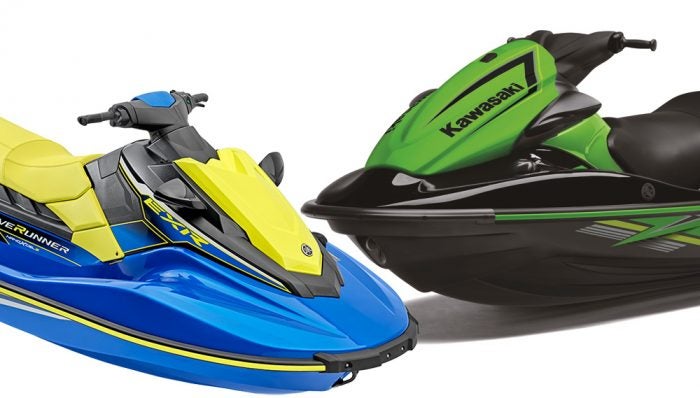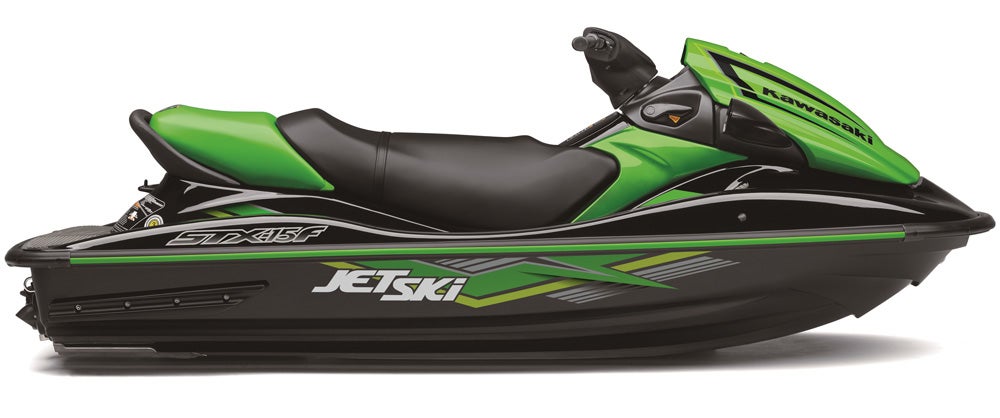2019 Yamaha EXR vs. 2019 Kawasaki STX-15F: By the Numbers
The 2019 Yamaha EXR and Kawasaki STX-15F take completely different approaches to the affordable PWC market.
For 2019, there are more options for personal watercraft enthusiasts looking for high-performance PWC without the sky-high prices often associated with them. For PWC riders looking for lightweight, lower-cost fun, the 2019 Yamaha EXR is intriguing. How will it compare to other PWC in the price range? Let’s see how it stacks up to the 2019 Kawasaki Jet Ski STX-15F, a well-known and popular powerhouse in the range, by the numbers.
Power Plants
When it comes to performance, we have to go to the heart of the matter, and in this case that means the engines. With the new Yamaha, the EXR is powered by a high-output 1,049cc three-cylinder, four-stroke TR-1 marine engine that feeds a 144mm high-pressure pump. In the EXR, the engine is a modified engine control unit (ECU) that gives the Waverunner a 10% increase in horsepower over the rest of the Yamaha EX lineup. Adding to the power delivery, the EXR has a top-loader intake and a 40mm jet pump extension that increases acceleration response.
The Kawasaki is powered by a thunderous inline, four-stroke, 1,498cc marine engine that has four valves per cylinder that produces 160 horsepower pumping out through a 148mm axial-flow, single-stage jet pump. It produces 957 pounds of thrust. The STX has set a standard for power and performance in the price range and continues to do so.
Closing the Gap
The Kawasaki lists the curb weight of the STX at 844.5 pounds. This is fully lubed and fueled. The STX has a composite hull that Kawasaki calls a “smooth-water specialist.” It comes with a newly updated digital instrumentation panel and Kawasaki’s Smart Steer system that aids in maintaining control of the PWC at speed when you let of the throttle. This helps keep you in control of the STX at all times, and for all skill levels. New riders will also appreciate the Special Learning Operation, or SLO Mode that lets new riders get used to handling the machine before they get in over their heads.
The Yamaha lists the dry weight of the EXR at 540 pounds, making one of the lightest runabout PWC on the market. It has Yamaha’s Nanoxcel 2 composite hull and deck to help give it a sturdy platform with reduced weight. This is the lowest priced Yamaha to come with this hull and deck material. The weight is a full 60 pounds lower than an EX Deluxe. The EXR also has Yamaha’s RiDE dual throttle system, which gives you exceptional maneuverability.
In the End
When it comes right down to it, you have Kawasaki’s brute power versus Yamaha’s light weight and high output engine. Is one better than the other? That’s for you to decide. The 2019 Yamaha EXR comes in Azure Blue with Lime Yellow color scheme. It looks very sharp and will set you back $9,299, a steal for this level of performance. The 2019 Kawasaki STX-15F comes in Ebony and Kawasaki Lime Green, always a sharp combination. The Kawi costs $9,699 and for that, you get a ton of reliable performance and power. There is now wrong way to go here, so pick the one you like best and go rip up the water.
Get PersonalWatercraft.com in your Inbox!
Like PersonalWatercraft.com on Facebook
Comments
Most Popular

2025 Yamaha JetBlaster PRO 2-Up Review

Remembering the Sea-Doo XP

2024 Kawasaki Jet Ski STX 160X Review

Whatever Happened to the Wetbike?

2025 Yamaha JetBlaster Review
















 Your Privacy Choices
Your Privacy Choices